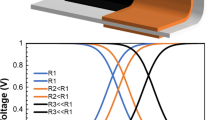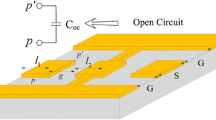Abstract
This paper seeks to demonstrate the functionality and verify the capabilities of capacitance adjustment by a self-folding device. The self-folding devices using polyvinyl chloride (PVC) shrink wrap and copper foil tapes with predefined creases were fabricated. By modifying a simple self-folding device and exposing it to a temperature between 50 to 90 degrees Celsius, the capacitor plates could be angled from 15 to 90 degrees. As a result, the capacitance changed as the inner angle decreased, from only 0.724 picofarads measured at 90 degrees, to 2.27 picofarads measured at 15 degrees. With the capacitance for each angle obtained, the next phase of development was conducted, to determine the tune-ability using a passive high pass filter. By scaling up the number of self-folding capacitors to thirty times, a cut-off frequency of 4.99 kHz at 15 degrees up to 7.25 kHz at 75 degrees was measured. As a result, this paper’s unique way of turning a self-folding device into a capacitor demonstrates great potential for development of tunable filters using capacitance adjustment and self-folding.
Similar content being viewed by others
References
H. Eren, Capacitance measurement, Encyclopedia of Electrical & Electronics Engineering, 3(1) (1999) 1–15.
F. Haas and R. J. Wootton, Two basic mechanisms in insect wing folding, Proceedings of the Royal Society of London. Series B: Biological Sciences, 263(1377) (1996) 1651–1658.
P. H. Todd, A geometric model for the cortical folding pattern of simple folded brains, Journal of Theoretical Biology, 97(3) (1982) 529–538.
T. Eisner, Leaf folding in a sensitive plant: A defensive thorn-exposure mechanism, Proceedings of the National Academy of Sciences, 78(1) (1981) 402–404.
H. Kobayashi, B. Kresling and J. F. Vincent, The geometry of unfolding tree leaves, Proceedings of the Royal Society of London. Series B: Biological Sciences, 265(1391) (1998) 147–154.
S. Ahmed, Z. Ounaies and M. Frecker, Investigating the Performance and Properties of dielectric elastomer actuators as a potential means to actuate origami structures, Smart Materials and Structures, 23 (2014) 094003.
N. Bassik, G. M. Stern and D. H. Gracias, Micro-assembly based on hands free origami with bidirectional curvature, Applied Physics Letters., 95(9) (2009) 091901.
J. Guan, H. He, D. J. Hansford and L. J. Lee, Self-folding of three-dimensional hydrogel microstructures, Journal of Physical Chemistry B, 109(49) (2005) 23134–23137.
R. Niiyama, D. Rus and S. Kim, Pouch motors: Printable/inflatable soft actuators for robotics, IEEE International Conference on Robotics and Automation (2014) 6332–6337.
E. Hawkes, B. An, N. M. Benbernou, H. Tanaka, S. Kim, E. D. Demaine, D. Rus and R. J. Wood, Programmable matter by folding, Proceedings of the National Academy of Sciences, 107(28) (2010) 12441–12445.
Y. Liu, J. K. Boyles, J. Genzer and M. D. Dickey, Self-folding of polymer sheets using local light absorption, Soft Matter, 8(6) (2012) 1764–1769.
M. T. Tolley, M. S. Felton, S. Miyashita, D. Aukes, D. Rus and R. J. Wood, Self-folding origami: shape memory composites activated by uniform heating, Smart Materials and Structures, 23(9) (2014) 094006.
S, Miyashita, C. D. Onal and D. Rus, Multi-crease self-folding by global heating, Artificial Life, 21(4) (2015) 398–411.
M. S. Felton, P. K. Becker, M. D. Aukes and J. R. Wood, Self-folding with shape memory composites at the millimeter scale, Journal of Micromechanics and Microengineering, 25(8) (2015) 085004.
J. Ramirez-Angulo, Bandpass filters, Encyclopedia of Electrical & Electronics Engineering, 2(2) (1999) 218–222.
P. Horowitz and W. Hill, The Art of Electronics., 2nd Edition (1994) 59.
E. Iwase and I. Shimoyahma, Multistep sequential batch assembly of three-dimensional ferromagnetic microstructures with elastic hinges, Journal of Microelectromechanical Systems, 14(6) (2015) 1265–1271.
S. Miyahita, C. D. Onal and D. Rus, Self-pop-up cylindrical structure by global heating, IEEE/RSJ International Conference on Intelligent Robots and Systems (2013) 4065–4071.
M. T. Tolley, L. Meeker, S. Miyashita, D. Rus and R. J. Wood, Self-folding miniature elastic electric devices, Smart Materials and Structures, 23(9) (2014) 094005.
Y. Liu, J. Genzer and M. D. Dickey, 2D or not 2D: Shape-programming polymer sheets, Progress in Polymer Science, 52 (2016) 79–106.
C. D. Santangelo, Extreme mechanics: Self-folding origami, Annual Review of Condensed Matter Physics, 8 (2017) 165–183.
S. Sundaram, D. S. Kim, M. A. Baldo, R. C. Hayward and W. Matusik, 3D-printed self-folding electronics, Applied Materials & Interfaces, 9(37) (2017) 32290–32298.
G. J. Hayes, Y. Liu, J. Genzer, G. Lazzi and M. D. Dickey, Self-folding origami microstrip antennas, IEEE Transactions on Antennas and Propagation, 10(62) (2014) 5416–5419.
M. Nogi et al., Foldable nanopaper antennas for origami electronics, Nanoscale, 10(5) (2013) 4395–4399.
K. Han, C. W. Sheilds, N. M. Diwakar, B. Bharti, G. P. Lopez and O. D. Velev, Sequence-encoded colloidal origami and microbot assemblies from patchy magnetic cubes, Science Advances, 8(3) (2017).
C. M. Andres, J. Zhu, T. Shyu, C. Flynn and N. A. Kotov, Shape-morphing nanocomposite origami, Langmuir, 30 (2014) 5378–5385.
R. Bhattacharyya, C. D. Leo, C. Floerkemeier, S. Sarma and L. Anand, RFID tag antenna based temperature sensing using shape memory polymer actuation, IEEE Sensors, Kona, HI, USA, 1–4 Nov. (2010).
Author information
Authors and Affiliations
Corresponding author
Additional information
Recommended by Associate Editor Hugo Rodrigue
Paul Chastain received a Bachelor of Science degree in Mechanical Engineering in 2019 from the Georgia Southern University in Statesboro, GA, USA. His current research interests include self-folding technology, soft robotics, and self-driving car technology.
Minchul Shin received the B.S. degree from Kyungpook National University, Daegu, Korea, in 2005, the M.S. degree from University of Alabama at Birmingham, and the Ph.D. degree from the Tufts University in 2012, specializing in Microelectromechanical Systems (MEMS) and Micro/Nano Fabrication. Following his Ph.D, he worked as a postdoctoral fellow at the University of Michigan with a research concentration on thin film micro-robot design. He is currently an Assistant Professor with the Department of Mechanical Engineering at Georgia Southern University, Statesboro, GA. His research interest lies in soft robotics, MEMS design, sound source detection, and micro robotics.
Rights and permissions
About this article
Cite this article
Chastain, P., Shin, M. Development of tunable filters using self-folding technology. J Mech Sci Technol 33, 1891–1896 (2019). https://doi.org/10.1007/s12206-019-0341-y
Received:
Revised:
Accepted:
Published:
Issue Date:
DOI: https://doi.org/10.1007/s12206-019-0341-y




